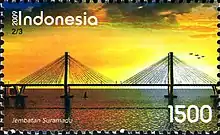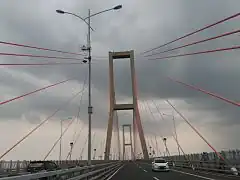Suramadu National Bridge Jembatan Nasional Suramadu | |
|---|---|
 Suramadu Bridge | |
| Coordinates | 7°11′3″S 112°46′49″E / 7.18417°S 112.78028°E |
| Carries | Vehicles |
| Crosses | Madura Strait |
| Locale | East Java (Surabaya-Bangkalan Regency) |
| Official name | Jembatan Nasional Surabaya–Madura |
| Characteristics | |
| Design | Cable stayed bridge Box girder bridge |
| Total length | 5,438 m (17,841 ft) |
| Width | 30 m (98 ft) |
| Height | 146 m (479 ft) |
| Longest span | 434 m (1,424 ft) |
| Clearance below | 35 m (114.8 ft)[1] |
| History | |
| Construction start | 20 August 2003 |
| Opened | 10 June 2009 |
| Statistics | |
| Daily traffic | 26,737 (2018)[2] |
| Toll | Free[3] |
| Location | |
The Suramadu Bridge (Indonesian: Jembatan Suramadu), also known as the Surabaya–Madura Bridge, is a cable-stayed bridge between Surabaya on the island of Java and the south of Bangkalan Regency on the island of Madura in Indonesia.[4] Opened in June 2009,[5] the 5.4-kilometre-long (3.4 mi) bridge is the longest in Indonesia and the second longest in southern hemisphere. It is the first bridge to cross the Madura Strait.[6]
The cable-stayed portion has three spans with lengths 192 metres (630 ft), 434 metres (1,424 ft), and 192 metres (630 ft). The bridge has two lanes in each direction plus an emergency lane and a dedicated lane for motorcycles in each direction.[7]
History
Early history

The idea of a bridge connecting Surabaya with Madura is said to have first been proposed in the early 1960s by the well-known Indonesian engineer Professor Sedyatmo from the Bandung Institute of Technology. Later, in the mid-1980s, there was renewed interest in the project when staff from the National Development Planning Bureau (Bappenas) met with Japanese aid donors to discuss the construction of a bridge.[8] A pre-feasibility study was prepared in early 1990 and in December 1990, President Suharto appointed a team of ministers and advisers to consider plans for the bridge.[9] Later, a consortium consisting of the Indonesian state-owned firm PT Jasa Marga and other Indonesian firms along with Japanese firms (Mitsubishi Corporation, Itochu, Shimizu, and the Long Term Credit Bank) was established to proceed with the bridge.
Further developments

In 1997-98, a range of problems arising from the Asian financial crisis in Indonesia led to the suspension of activities. However, within a few years, the East Java Provincial Government took up a renewed interest in plans and 2000 announced that further initiatives would be taken at the provincial level. These steps gained impetus when President Megawati issued a decree instructing ministers to take additional steps to support the construction of the bridge and appoint PT Jasa Marga as the lead Indonesian firm for the project.[10]
The bridge was built by a consortium of Indonesian companies PT Adhi Karya and PT Waskita Karya working with China Road and Bridge Corp. and China Harbor Engineering Co. Ltd. The total cost of the project, including connecting roads, has been estimated at Rp4.5 trillion (US$445 million).[11]
Construction began in August 2003. In July 2004, a girder collapsed, killing one worker and injuring nine others. Work on the bridge halted at the end of 2004 due to lack of funds, but was restarted in November 2005. The main span of the bridge was connected on 31 March 2009[12] and the bridge was opened to the public on 10 June 2009.[13]
Within a week of the opening, it was discovered that nuts and bolts as well as maintenance lamps had been stolen and that there was evidence of vandalism of cables supporting the main span.[14]
Tariffs
As is often the case with public sector infrastructure facilities in Indonesia, there has been pressure to keep the tariffs for the use of the bridge low. Tolls were initially set at Rp30,000 (US$3 in 2009) for four-wheeled vehicles and Rp3,000 (US$0.30) for two-wheelers.[15] However, in early 2016, it was announced that President Jokowi favored a 50% cut in the tolls to help promote the competitiveness of industries on the Madura side of the bridge.
No details were available as to how the cuts in the tolls would be funded.[16] However, a spokesperson for the state-owned company PT Jasa Marga which operated the bridge said that the reductions in tariffs would not cause a problem for the operating firm itself because Jasa Marga was paid directly by the government to manage the bridge.[17]
Starting 27 October 2018, toll tariffs were abolished for all types of vehicles.[18]
Gallery
References
- ↑ Media, Kompas Cyber (1 May 2009). "Kapal Apa Saja yang Tidak Boleh Lewat Kolong Suramadu? - Kompas.com". KOMPAS.com. Retrieved 26 September 2018.
- ↑ "Antisipasi Kemacetan, Jasa Marga Lakukan Rekayasa di Tol Suramadu". www.infopublik.id. Retrieved 26 September 2018.
- ↑ PUPR, Badan Pengatur Jalan Tol | Kementerian (29 October 2018). "Badan Pengatur Jalan Tol | Kementerian PUPR". bpjt.pu.go.id. Retrieved 4 November 2018.
- ↑ Indra Harasputra, 'Special report:Suramadu bridge could last for 100 years', The Jakarta Post, 10 June 2009.
- ↑ "The Suramadu Bridge". The Jakarta Post. 10 June 2009. Retrieved 10 June 2009.
- ↑ Taufiq, Rohman (10 June 2009). "Indonesia Launches First Inter-Island Bridge". Tempo. Archived from the original on 22 February 2012. Retrieved 10 June 2009.
- ↑ VIVA, PT. VIVA MEDIA BARU - (1 May 2009). "Motor Boleh Nyebrang Lewat Suramadu – VIVA" (in Indonesian). Retrieved 26 September 2018.
- ↑ Jack Spotten, 'Iniliah Sejarah Singkat Jembatan Suraamadu Yang Perlu Kita Tahu' (Need to Know: Short history of the Suramadu Bridge), #TandaPagar, 2 January 2016, accessed 22 July 2018.
- ↑ Presidential Decision (Keputusan Presiden) No 55 of 1990, dated 14 December 1990.
- ↑ Presidential Decision (Keputusan Presiden) No 79 of 1993, dated 27 October 2003.
- ↑ Witular, Rendi A. (10 June 2009). "Special Report: 'Made in China' poses as RI's pride". The Jakarta Post. Retrieved 10 June 2009.
- ↑ "Akhirnya, Bagian Tersulit Pada Jembatan Suramadu Tersambung" (in Indonesian). Suramadu Bridge Project. 1 April 2009. Retrieved 10 June 2009.
- ↑ "Sebanyak 6.500 Undangan Hadiri Peresmian Jembatan Suramadu" (in Indonesian). Suramadu Bridge Project. 9 June 2009. Retrieved 10 June 2009.
- ↑ Tejo, Amir (17 June 2009). "Newly Opened East Java Bridge Gets Pilfered For Scrap Metal And Used Parts". The Jakarta Globe. Archived from the original on 19 June 2009. Retrieved 21 June 2009.
- ↑ "Suramadu Toll Bridge Fares Announced". Kompas. 10 June 2009. Retrieved 10 June 2009.
- ↑ Ayomi Amindoni, 'Govt to cut Suramadu Bridge tolls', The Jakarta Post, 4 February 2016.
- ↑ 'Govt cuts Suramadu bridge fee by 50 percent', The Jakarta Post, 1 March 2016.
- ↑ Dwinanda, Reiny (28 October 2018). "Jokowi announces no more toll fee in Suramadu bridge | Republika Online". Republika Online. Retrieved 4 November 2018.










.jpg.webp)


